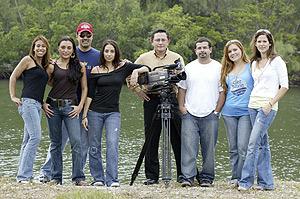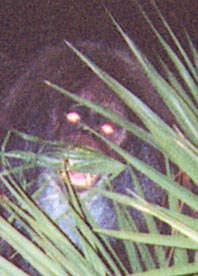Footprints
Posted by: Loren Coleman on January 2nd, 2007

This year is starting off with a bang regarding the Skunk Ape. First, I wondered aloud if it was time to ponder the Myakka case anew (please note, not "Port Myakka" as given below), and now this (first published overnight with a different headline, since updated here, as it appears in today’s paper):
January 02, 2007
Miami Herald
"Kids armed with cameras chase after the Skunk Ape"
by Curtis Morgan
The scene: the Everglades, mysterious in the darkness.
Four college kids, armed only with a night-vision camera, trudge through palmetto thicket, guided by a snake-booted man who claims to have had multiple encounters with the state’s most elusive creature.
They seek a half-man, half-simian, fully reeking legend known as the Skunk Ape.
A curious rustling draws them closer. Nervous patter. Closer. What is making those sounds? Closer. Suddenly, a blinding flash, screams and…
This is not some cheesy monster movie. It’s the real experience of Florida International University film students who spent months on the trail of one of the shaggiest tales in folklore — the Skunk Ape, aka Florida’s Bigfoot.
What they found in Footprints, a brisk and engaging documentary completed last month for a class project, won’t rewrite anthropology texts.
Turns out that unsettling flash came from an automatic camera set up by their guide to record what a skeptical world still awaits — ironclad evidence of the existence of the Skunk Ape, Yeti, Sasquatch and other hulking, hairy relations.
"We looked and we looked and, of course, we didn’t find anything. We came to the conclusion that it’s a myth," said Romy Santana, one of eight seniors who teamed on the film.
No Put-Downs
And yet after much digging, talks with claimed witnesses, interviews with scholars of Bigfoot lore and other experts, they’re not dismissing every believer as hoaxer or wacko either.
"There are a lot of things going on in the Everglades, a lot of reports of smells and sightings and a whole bunch of things," Santana said. "Who are we to say because we didn’t see it, it doesn’t exist? Maybe there is something out there."
At least in the public imagination. Several websites about "cryptozoology" — that being the study of supernatural creatures — chronicle steady sightings.

Most recently, there was 2004’s Green Swamp Ape episode in the Panhandle and the mysterious, much-analyzed Port Myakka photos of 2000 depicting an orangutanish beast hunkered behind saw palmetto. In 1997, a flurry of reports emerged from the Big Cypress National Preserve, including a supposed sighting by a busload of British tourists.
In the 1970s, the infamous Green Chimp apparently stalked south Broward County. A decade earlier, rumors circulated about a Bigfoot in Everglades National Park, possibly held under government guard.
Still, the students — Santana, Kallie Burke, Kirmaya Cevallos, Maria Delgado, Claudia Echeverria, Juan Carlos Gonzalez, Lino La Rosa and Luis Vale — confessed to knowing squat about Sasquatch when they started. The project began when Bert Delgado, an associate professor of film at FIU, teamed them for a final test before graduating — make a movie, anything from a music video or a thriller to a documentary.
In a brainstorming session, Cevallos brought up a beast she had once seen on TV, a story that stuck in her mind.
"It just caught my attention about the Everglades, about how huge it really is and how little I knew about it," Cevallos said. "It’s a myth you always think about."
It offered an entertaining mix of mystery, history and nature. Plus, for students with a lean budget (ultimately, about $700), the story had the practical benefit of providing a beautiful and absolutely free scenic backdrop.
What they wound up putting together looks as slick as much of what airs on cable. They filmed on location in the Everglades and Big Cypress. Vale even managed to sweet-talk a helicopter business into a free flight over the Glades.
No Ape Suits
Though at less than 15 minutes, it’s shorter than professional features produced in the past, including episodes of the In Search Of and Unsolved Mysteries series, Footprints covers a lot of ground and never stumbles into spoof or hype. Nobody, for instance, shows up in an ape suit in the few "re-created" sightings.
"The topic really surprised me," said Professor Delgado, who gave a thumbs-up that echoed reviews from friends and fellow students. "They were really interested in this thing, and they went after it. To me, it was very appealing."
Though it uncovers nothing shocking, the film features interviews with both notable and notorious Skunk Ape authorities, who offer thoughtful and sometimes surprising ruminations on the phenomenon.
There’s David Shealy, tireless promoter and proprietor of a Skunk-Ape theme campground in tiny Ochopee on the Tamiami Trail, who guided them on that semi-scary walk.
There’s Scott Marlowe, a cryptozoologist who recounts the eerie feeling of a Skunk Ape staring at him in woody outskirts of Orlando.
And Loren Coleman, perhaps the foremost cryptozoologist and author of Bigfoot books, including a field guide describing five types going by about 500 different names.
Coleman, based in Maine, said he has spent years sifting through reports and dismisses perhaps 80 percent of them as hoaxes or misidentification.
"Being a cryptozoologist doesn’t mean you just openly, hook, line and sinker, take everything in," he said. But tossing those aside, there’s enough hair, prints and reliable reports that "I accept right now that there seems to be an abundance of evidence that the Skunk Ape exists."
One well-respected South Florida anthropologist — Bob Carr, executive director of the Archaeological and Historical Conservancy in Davie and a man who helped uncover and preserve the Miami Circle — won’t go that far.
But Carr, long fascinated by the sociology and psychology behind Bigfoot, would "never eliminate the possibility" of something like a Skunk Ape. He has interviewed credible witnesses himself, he said, and seen reputed hair, footprints and a lot of collected material to support a hoary myth.
"A Complex Answer"
"If you tried to pin me down, I’d have to say, `Well, there is no proof that the creature exists,’" he said. But, "It’s a complex answer, and it doesn’t fall easily into saying yes or no."
Carr and Ron Magill, Metrozoo’s director of communications, are the film’s voices of logic and skepticism.
Magill points out the utter absence of verifiable evidence: no body or clear photo after a century of sighting. No conclusive DNA tests on dung or hair. And with so few, just where are Bigfoot babies coming from, anyway?
"I’m one of those people who want to believe the thing exists," Magill said. "It would be one of the greatest discoveries of
the millennium."
Photo at the top: The Hunt is On: FIU students, from left, Romy Santana, Kirmaya Cevallos, Luis Vale, Maria Delgado, Lino LaRosa, Juan Carlos Gonzalez, Kallie Burke and Claudia Echeverria have made a documentary about Florida’s legendary bigfoot known as the Skunk Ape (Photograph by Patrick Farrell/Miami Herald).
About Loren Coleman
Loren Coleman is one of the world’s leading cryptozoologists, some say “the” leading living cryptozoologist. Certainly, he is acknowledged as the current living American researcher and writer who has most popularized cryptozoology in the late 20th and early 21st centuries.
Starting his fieldwork and investigations in 1960, after traveling and trekking extensively in pursuit of cryptozoological mysteries, Coleman began writing to share his experiences in 1969. An honorary member of Ivan T. Sanderson’s Society for the Investigation of the Unexplained in the 1970s, Coleman has been bestowed with similar honorary memberships of the North Idaho College Cryptozoology Club in 1983, and in subsequent years, that of the British Columbia Scientific Cryptozoology Club, CryptoSafari International, and other international organizations. He was also a Life Member and Benefactor of the International Society of Cryptozoology (now-defunct).
Loren Coleman’s daily blog, as a member of the Cryptomundo Team, served as an ongoing avenue of communication for the ever-growing body of cryptozoo news from 2005 through 2013. He returned as an infrequent contributor beginning Halloween week of 2015.
Coleman is the founder in 2003, and current director of the International Cryptozoology Museum in Portland, Maine.










One correction, the ’04 Green Swamp sighting did not happen in the panhandle. as the Green Swamp is not up there. I live in the Green Swamp and can swear that I am in Central Florida, just south of Orlando.
I assume they are talking about the sighting that occurred right after Hurricane Charlie swept through.
“Port Myakka” is not the only boo-boo.
This made me blink: “cryptozoology” — that being the study of supernatural creatures…”
The students at least went and looked.
Myakka, Green Swamp, incorrect dates, wrong definitions. We who were interviewed were lucky to get out with our lives!
I still find it interesting that it mentions the students ‘never stumble into spoof or hype’. Good for them. They took their project seriously, and though they made a few errors, I commend their attitude and attempt to make a serious study of their topic.
I noticed the group was three guys and five girls!
Man! Bigfoot hunters must get all the chicks!
Maybe I missed it in the column, but when can we expect to see this documentary and how? I hope they put as much effort into content as they did with the shabby chic distressed typography and spooky soundtrack. 😉